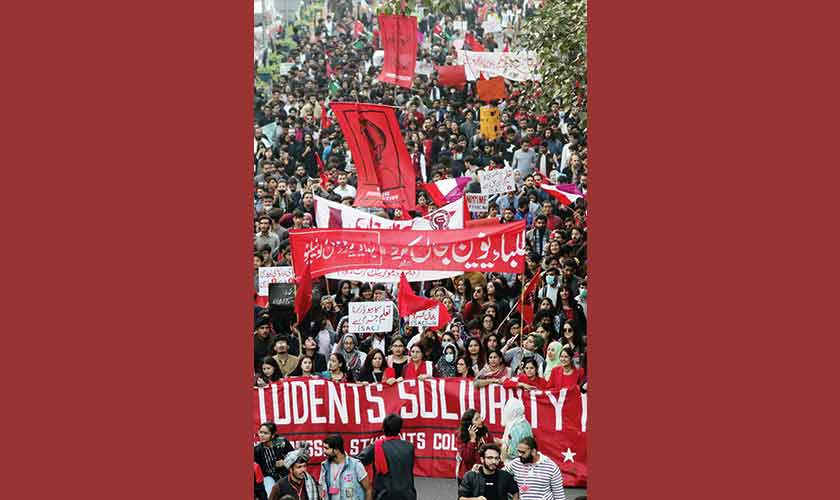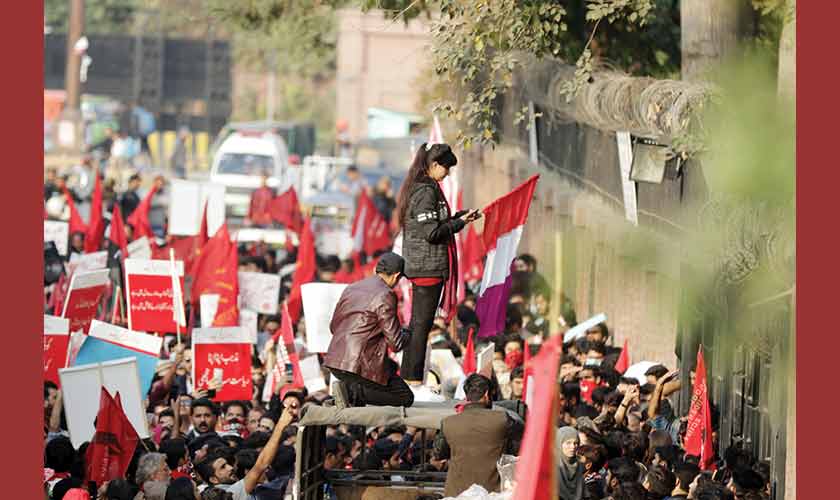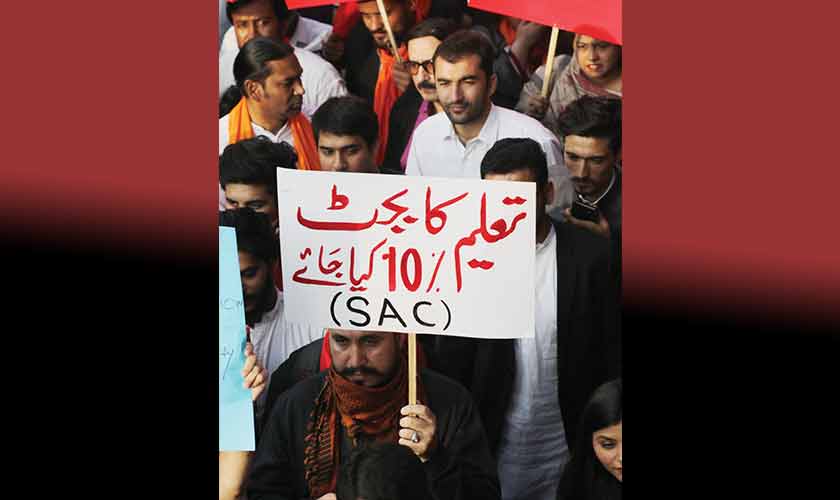Farah Zia
A week later, it appears that the purpose of the Students Solidarity March is served. The concerns raised by the students and organizers have forced everyone to sit up and take notice; a debate has started at several forums.
It was a sunny, expectation-laden, afternoon at Lahore’s Istanbul Chowk on November 29. The procession that stood near Nasser Bagh at 3pm was already delayed by an hour. Soon, the promised march to the Charing Cross began. The now-familiar leaders of Progressive Students’ Collective stood atop a truck, holding big microphones in their hands. As the truck started moving, everyone gathered around. A big red banner with Students Solidarity March painted on it in white was carried by young women leading the march.
As of now, the students are energized and ready to take on the mantle of leadership that they have been unjustly denied. There can be no academic freedom till students have the right to association.
The color red dominated in a crowd which seemed bigger than everyone’s expectations. No wonder the students were charged. They were joined in the march by teachers, journalists, lawyers, old guard revolutionaries, civil society activists, working classes, political workers. All genders were represented in the inclusive crowd that the Mall has not seen in recent years. Not even in the Lawyers’ Movement. The non-Punjabi youth were conspicuous by their sizeable number. A rare occasion when the ‘burgers’ mingled with their public school counterparts in a public space.
Rejuvenated by slogans of resistance, A R Rehman’s Chale Chalo and other songs blaring from the music system installed on the truck lent goosebumps-causing moments to the marchers. Keeping pace with the truck, along one side of The Mall, closed for traffic; for once they outnumbered the policemen who guard such marches.
The march ended at its stated destination but the show went on. The fact that it looked like a freedom carnival had a context. There were immediate issues like; budget cuts in education and harassment of female students in Balochistan University by the administration that irked the protestors. Moreover, the apathy of the political system in tacking these issues and censorship on media resulted in one everyone chanting slogans for freedom — Azadi.
The students’ formal demands addressed more systemic issues like restoration of student unions, uniform curricula and education system, more budget for education and the demilitarisation of campuses.
The tragic collective memory of Mashal Khan’s brutal murder at the hands of his fellow students in Mardan, the continued incarceration of Junaid Hafeez in Multan on blasphemy allegations, and the stabbing to death of Professor Khalid Hameed in March at the hands of his student in Bahawalpur this year; provided an apt backdrop for the students to unite and do something about their lives. The consistent mobilisation of Progressive Students’ Collective over the last many years, the marches organised by the Pahstun Tahaffuz Movement last year, and the holding of Aurat Marches had all come together in creating this critical mass of students who came out to challenge the status quo.
By evening, it was clear that similar protests were being held in cities and towns across Pakistan, even in Gilgit-Baltistan, led by students who identify with progressive causes and were united under a Students Action Committee. Apparently, the misgivings and social media campaigns raised against them could not stop the marches from taking place.
The actual crackdown began a day later, with one Pashtun speaker, a former Punjab University student, picked from the university premises, and two days later charged with sedition. More cases against some known faces like Professor Ammar Jan, Farooq Tariq and Mashal Khan’s father Iqbal Lala and hundreds of unidentified protesters were registered. A political science teacher Akhtar Khan was also arrested under the Cybercrime Act in the aftermath of the march.A week later, however, it appears that the purpose of the march is served. The issues and concerns raised by the students and organisers have forced everyone to sit up and take notice. A debate has started at several forums, particularly about the need to revive student unions in educational institutions. The high-handed acts of the government apart, ministers and even the prime minister, have underscored the need to bring back student unions albeit with a few caveats attached.But the debate will not remain confined to unions alone; it will trace its antecedents in history as it is already doing and search for future courses of action. Students insist that if the 1968 student movement that shook the foundations of a military dictator is to be seen in the light of a world-wide movement, then today’s events should also be seen in the backdrop of student awakening across the world.
Their demand for a uniform education system will inevitably raise the legitimate question about the privatisation of education, the class-based and individual-centered citizenry it produced, and the death blow it inflicted on the public sector. Attention is being drawn to how the state has tried to realise its own extreme values through education, and has hence repressed the students. Though what the country has now, as a consequence, is students who understand the world in only black and white terms, through the lens of religion and narrow nationalism.
In the week before and after the march, organisers have spoken to media-people of all hues. They have not shirked any question and, in doing so, have educated us all. In the last few decades, the producers of media have projected the problems of middle classes as ‘the’ problems of the country. Obviously, collective action, equal distribution of wealth and opportunities, social equality through education, student unions seem such alien concepts today; even the colour red is a red rag to the middle class consumers of media.
A section of media sees in the march almost a ‘conspiracy’ to launch a new political party, and that too of the ‘left’. The suggestion being that that was clearly unforgivable.
As of now, the students are energised and ready to take on the mantel of leadership that they have been unjustly denied. There can be no academic freedom till students have the right to association, they think. The complexion of the march suggests that they are seeking solidarity from their seniors and thereby learning from history. The most remarkable role, indeed, has been that of teachers. Some who are trained abroad are concerned about the student issues here, and are equal partners with them in their struggle.
Unfortunately, the state is trying to scare them both, by lodging sedition cases against them.
There can’t by anything more heady, romantic and plain right than the youth seeking equality in the world they inhabit. If not now, when? Students sorting out their own issues through consensus can give this country and its democracy the confident and moral leadership it so badly needs. The sooner the state realises this, the better.
https://www.thenews.com.pk/tns/detail/579461-the-march-and-after




No comments:
Post a Comment